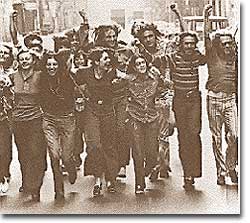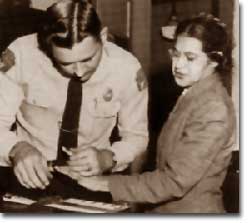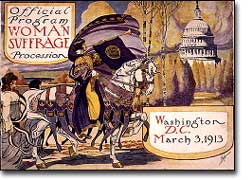10a. Rights and Responsibilities of Citizens

Following the "Stonewall Riots" of 1969 in New York City, American homosexuals began an aggressive campaign for their civil rights.
As much as the founders talked and wrote about liberty, they didn't have much to say about equality.
Thomas Jefferson's famous phrase in the Declaration of Independence proclaimed that "All men are created equal." By today's standards, that statement is problematic because it says nothing about women. The word "equality" is used nowhere in the Constitution or in the Bill of Rights. The goals of the early United States were much more centered on liberty, but over the years equal rights have come to be more and more important.
Civil Rights in Early National History
Civil rights — such as voting and owning property — in early America were mostly restricted to white men. Most African Americans were brought to America as slaves who, under the Constitution, were only counted as three-fifths of a person. After the Civil War slavery was abolished by the 13th Amendment, and voting rights were granted to African Americans in the 15th Amendment. But the most important change of the post-Civil War era was the 14th Amendment's famous clause: "No State shall ... deny to any person within its jurisdiction the equal protection of the laws."

One afternoon in 1955 Rosa Parks sat in the front of a bus and became a symbol of the civil rights movement, after she was booked and fingerprinted for violating Montgomery, Alabama's segregation laws.
The search for equal rights was far from over with the passage of the 14th Amendment in 1868. State and local Jim Crow laws were enacted all over the South to segregate black and white Americans. The constitutionality of these laws was questioned in 1896 with the famous Plessy v. Ferguson case. Homer Plessy challenged a Louisiana state law that required the races to ride in "equal but separate" railroad cars. He claimed that the law violated the equal protection clause of the 14th Amendment. The Supreme Court fatefully ruled that segregation was not unconstitutional as long as the facilities were equal. The decision effectively prevented the application of the 14th Amendment for more than a half a century.
Modern Civil Rights Movement
The movement for equal rights gained its momentum in 1954 with the Supreme Court's decision in Brown v. Board of Education of Topeka. The case overturned Plessy's separate but equal doctrine, and declared that separate but equal public facilities were unconstitutional. The decision alone was not enough to begin the civil rights movement. The case was argued by the National Association for the Advancement of Colored People, an interest group whose cause was validated by the Court's decision.
The focus of the early movement was on African Americans, with many citizens and organizations joining in. Martin Luther King's charismatic leadership helped to propel the movement to the forefront of the nation's agenda. Nonviolent protests, demonstrations, sit-ins, and boycotts sparked Presidents to act, and finally Congress passed two significant laws — the Civil Rights Act of 1964 and the Voting Rights Act of 1965. Together they virtually ended de jure segregation — separation by law. But much de facto segregation — separation by fact — has remained.
Civil Rights for Women

This colorful invitation to join a suffragist parade was a bold call to action in 1913, when women didn't have voting rights nationwide. This changed with ratification of the 19th Amendment in 1920.
The civil rights movement reawakened another major effort for equal rights — civil rights for women. Women had won the right to vote in 1920 after a struggle that effectively had begun in 1848 with a historic organizational meeting in Seneca Falls, New York. The movement lost momentum after its main goal was reached, but during the 1960s, new leaders emerged who demanded women's "liberation."
New organizations, such as the National Organization for Women (NOW), focused on eliminating gender discrimination in the work force and school. They demanded equal legal rights, such as owning property and easier access to divorce, for women. They fought for economic equality in the form of equal pay for equal work and broader admission into male-dominated professions. Although the movement failed in its push to add the Equal Rights Amendment to the Constitution, it brought about many legal and social changes that supported more equal rights for women.
Equal Rights for All Americans
Many groups in American society were encouraged by the successes of the movements for African Americans and women, and much has happened in recent years to ensure equal rights for all. Major movements for Latinos, the elderly, the disabled, and homosexuals have heightened American awareness of discrimination against many other minorities.
The 14th Amendment guaranteed "equal protection of the law" more than a century and a half ago. The fact that it took so many years for its effects to be felt is testimony to the complexity of the decision-making process in a democracy. It took all three branches, active interest groups, and concerned individual citizens to bring the country closer to the ideal of equal rights for all.







